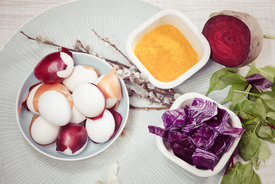WON Tips
Get the latest health & wellness and DIY tips from the friendly and knowledgeable staff at WON.
 Conventional food color dyes are created from an unrefined fuel-petroleum. Red #40 and Yellow #5 and #6 contain the chemical benzene, which is a known carcinogen, that most of the world has banned. These food dyes have been linked to long-term health problems such as brain tumors, bladder and thyroid cancer, and allergic reactions. Numerous studies have shown they increase hyperactivity in children and have a negative impact on children’s ability to learn, contributing to ADHD. Yellow #5 and #6 have also been shown to behave like estrogen in the body, disrupting hormones and contributing to breast cancer, low testosterone and increases the risk of developing metabolic disease. For most of us the terms food coloring, artificial food dye, synthetic food dye, etc. did not have a negative connotation as we were enjoying coloring our Easter Eggs, or making birthday cupcakes. Fast-forward to today and it is becoming more well known just how dangerous, and unnecessary, these dyes can be. The good news is that there are safe, fun, and creative options for making your own food colors. Coloring Easter Eggs is a fun tradition for all ages! When I began my journey to remove artificial dyes from my family’s diet, I was saddened to think that I would either need to sacrifice our beliefs or not partake in this activity. Thanks to the many resources that the Internet has to offer, I realized I had many options to naturally color Easter Eggs. From simple, bright colored eggs to pastels, to professionally looking eggs that are imprinted with flower and leaf designs, you are sure to find a beautiful, safe alterative to using harmful kits and dyes. Naturally Colored Easter Eggs At World of Nutrition we are happy to offer convenient, vibrant botanical color powders from Color Kitchen in Bright Blue, Beet Red and Yellow. These can be used to create frostings, icings, dye Easter Eggs and much more. These three primary colors can be mixed to create the following hues:
Dyes from Plants & Herbs Nature has provided us with countless plants and herbs that make beautiful Easter Eggs! Look around your kitchen; you probably have a handful of items already! Purple cabbage, spinach, turmeric, onion skins, and rosemary to list just a handful. Fresher ingredients will yield the richest colors. What I love about natural Easter egg coloring is you never know what colors you are going to get. A beautiful natural mystery! Red: Boil 1 to 2 beets (about 3/4 pound) roughly chopped, or a few teaspoons of red beet powder (can be found on the bulk wall at WON) in 1-quart water, 1-tablespoon vinegar, and 1-tablespoon salt, then cover and simmer for 30 minutes. Strain, reserving the liquid for dyeing. Yellow-Orange: Heat 1-quart water, 1-tablespoon vinegar, and 1-tablespoon salt in a saucepan. Add 6-tablespoon ground turmeric (can be found on the bulk wall at WON) and stir well. Simmer for just a few minutes until the turmeric dissolves. Faint yellow: Simmer the peels of 6 oranges in 1-1/2 cups water for 20 minutes; strain. Add 2 tsp. vinegar. Mustard-yellow: Stir 2 Tbsp. turmeric into 1 cup boiling water; add 2 tsp. white vinegar. Blue: Boil 1 large shredded red cabbage (about 1 pound), 1-quart water, 1-tablespoon vinegar, and 1-tablespoon salt. Bring to a boil, then cover and simmer 30 minutes. Strain, reserving the liquid for dyeing. To achieve a truly rich blue, the eggs need to soak for a few hours. Bluish-Gray: Mix 1 cup frozen blueberries with 1 cup water, bring to room temperature, and remove blueberries. Green: Frozen spinach works best for green eggs. Boil 10 oz. pkg. frozen spinach, 1 t. Baking Soda, and 2 cups of Water. Boil for 5 minutes, and then simmer for 60 minutes. Mush up spinach to release the color. Make sure water doesn’t simmer away! Tips:
First, begin with days that are at least 3 days old. Using white eggs will result in a brighter hue, while brown eggs will have a more neutral look. Place eggs in a large saucepan. Cover them with cool water by 1 inch. Slowly bring water to a boil over medium heat; when the water has reached a boil, cover and remove from heat. Let sit 12 minutes. Transfer eggs to a colander; place under cool running water to stop the cooking. Let cool completely before coloring. More Intricate Easter Eggs A WON staff favorite is using flowers, plants, leaves and herbs to creative designs on eggs. Taking a nature walk can be a fun way to find treasures to add to your eggs. The smaller the item, the better pattern it will create. Even herbs such as, rosemary and dill can be used. Simple place the plant on the hard boiled egg, hold tightly and place in a small piece of cheesecloth or pantyhose that have been cut up. Then proceed as usual with your choice of dying method. Let the egg dry for about 15 minutes before removing the cheesecloth or pantyhose. The options are limitless! Using yellow onion peels is another fun way to dye eggs. How to Dye Eater Eggs with Onion Skins: Ingredients
Yellow onion skins will dye the eggs a light tan, while red onion skins will yield a richer brown color. A mix of onions, as well as a selection of white and brown eggs will give you a pretty, varied palette of shades. Another fun way to use the Color Kitchen color packets this Easter is to make colored coconut to use as grass in Easter treats! Instructions Mix color with ¼ tsp. water in a small cup to dissolve Mix blended color with coconut and add another ¼ cup water in a food processor, or blend in a plastic bag with your hands Once mixed, put on a baking tray and set out to dry To speed up drying process, put tray in oven on warm and check every 5 minutes to make sure coconut is not turning brown and color does not fade.  At WON, we encourage your family to try these exciting, natural methods this Easter. Please don’t hesitate to contact us if you have any questions or wish to use any of the herbs or coloring kits that we have. Happy Easter!
0 Comments
|
Archives
October 2016
Categories |
